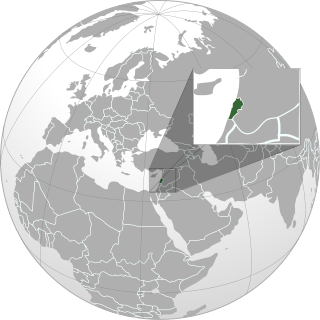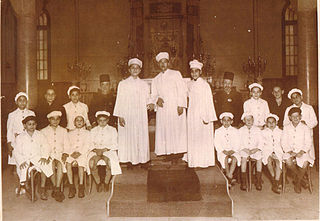| Sasson Synagogue | |
|---|---|
| Religion | |
| Affiliation | Judaism (former) |
| Ecclesiastical or organisational status | Synagogue |
| Status | Closed |
| Location | |
| Location | Rue Temple Sasson, Glymenopoulo, Alexandria |
| Country | Egypt |
| Architecture | |
| Funded by | Jacob Sassoon |
| Completed | 1910 |
The Sasson Synagogue, officially the Jacob Sasson Synagogue, is a former Jewish synagogue, that was located on Rue Temple Sasson, in the Glymenopoulo neighborhood of Alexandria, Egypt. The synagogue was completed in 1910 [1] and, despite its misspelling, was named in honour of Jacob Sassoon. [2]

A synagogue, also called a shul or a temple, is a place of worship for Jews and Samaritans. It has a place for prayer where Jews attend religious services or special ceremonies such as weddings, bar and bat mitzvahs, choir performances, and children's plays. They also have rooms for study, social halls, administrative and charitable offices, classrooms for religious and Hebrew studies, and many places to sit and congregate. They often display commemorative, historic, or modern artwork alongside items of Jewish historical significance or history about the synagogue itself.

The Jewish–Roman wars were a series of large-scale revolts by Jewish subjects against the Roman Empire between 66 and 135 CE. The term primarily applies to the First Jewish–Roman War and the Bar Kokhba revolt, nationalist rebellions striving to restore an independent Judean state. Some sources also include the Diaspora revolt, an ethno-religious conflict fought across the Eastern Mediterranean and including the Kitos War in Judaea.

Egyptian Jews constitute both one of the oldest and one of the youngest Jewish communities in the world. The historic core of the Jewish community in Egypt mainly consisted of Egyptian Arabic-speaking Rabbanites and Karaites. Though Egypt had its own community of Egyptian Jews, after the Jewish expulsion from Spain more Sephardi and Karaite Jews began to migrate to Egypt, and then their numbers increased significantly with the growth of trading prospects after the opening of the Suez Canal in 1869. As a result, Jews from many territories of the Ottoman Empire as well as Italy and Greece started to settle in the main cities of Egypt, where they thrived. The Ashkenazi community, mainly confined to Cairo's Darb al-Barabira quarter, began to arrive in the aftermath of the waves of pogroms that hit Europe in the latter part of the 19th century.

The history of the Jews in Lebanon encompasses the presence of Jews in present-day Lebanon stretching back to biblical times. While Jews have been present in Lebanon since ancient times, their numbers had dwindled during the Muslim era. Through the medieval ages, Jewish people often faced persecution, but retained their religious and cultural identity.

The Sassoon family, known as "Rothschilds of the East" due to the immense wealth they accumulated in finance and opium trade, are a Baghdadi Jewish family.

The Ben Ezra Synagogue, sometimes referred to as the El-Geniza Synagogue or the Synagogue of the Levantines (al-Shamiyin), is a former Orthodox Jewish congregation and synagogue, located in the Fustat part of Old Cairo, Egypt. According to local folklore, it is located on the site where baby Moses was found.

The New West End Synagogue is an Orthodox Jewish congregation and synagogue, located in St. Petersburgh Place, Bayswater, in the City of Westminster, London, England, in the United Kingdom. The congregation has been a member of United Synagogue since 1879.

The Eliyahu Hanavi Synagogue is an Orthodox Jewish congregation and synagogue, located at 69 Nabi Daniel Street, Alexandria, Egypt.

Jews comprise approximately 10% of New York City's population, making the Jewish community the largest in the world outside of Israel. As of 2020, over 960,000 Jews lived in the five boroughs of New York City, and over 1.9 million Jews lived in the New York metropolitan area, approximately 25% of the American Jewish population.
The Azouz Synagogue was a former Jewish synagogue, that was located near Souk el Hosr, in Alexandria, Egypt. It was one of the oldest synagogues in Alexandria. It is unknown when it was built, however it was rebuilt in 1853.
The Castro Synagogue was a former Jewish synagogue, that was located in the Moharam Bey district of Alexandria, Egypt. The synagogue was founded by Moshe Castro, completed in 1920, and located in the district that contained the homes of many wealthy Jewish families.
The Eliahou Hazan Synagogue was a former Jewish synagogue, that was located on the former Rue Belzoni, in Alexandria, Egypt. The synagogue was named after Rabbi Eliahou Hazan, the chief rabbi of Alexandria from 1888 to 1908. Established in 1937, it closed in 1958. It, along with many other synagogues, was later sold by the Jewish community of Alexandria in 1995.
The Green Synagogue was a former Jewish synagogue, that was located near Wabour Al Mey, Bab Sharqi, in the Moharam Bek neighborhood, in the Central District of Alexandria, Egypt. The synagogue was completed in 1901 and draws its name from its architect, Abraham Green.

The Menasce Synagogue is a Jewish synagogue, located in Ahmed Orabi Square, in Alexandria, Egypt.
The Shaaré Tefila Synagogue, also known as the Anzarut Synagogue, or Charbit Synagogue, was a former Jewish synagogue, that was located in the Camp Sheraz district of Alexandria, Egypt. The synagogue was completed in 1922 by the Enzarawat and Sharbein families.
The Zaradel Synagogue was a former Jewish synagogue, that was located on Rue de France, in the Old Fish Market, in Alexandria, Egypt. It was the oldest synagogue in Alexandria.
Hanan the Egyptian was a rabbi of the 2nd century who first lived at Alexandria. He later moved to Judaea and was active among the scholars of Jabneh. He was a disciple of Rabbi Akiva and is quoted among "those who argued before the sages." Only one law, relating to the Temple service on Yom Kippur, is preserved in his name.
The following is a timeline of the history of the city of Alexandria, Egypt.

The Peitav Synagogue or Peitav-Shul is an Orthodox Jewish congregation and synagogue, located at 6/8 Pietavas Street, Vecrīga, in Riga, Latvia.

The history of the Jews in Alexandria dates back to the founding of the city by Alexander the Great in 332 BCE. Jews in Alexandria played a crucial role in the political, economic, cultural and religious life of Hellenistic and Roman Alexandria, with Jews comprising about 35% of the city's population during the Roman Era.